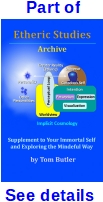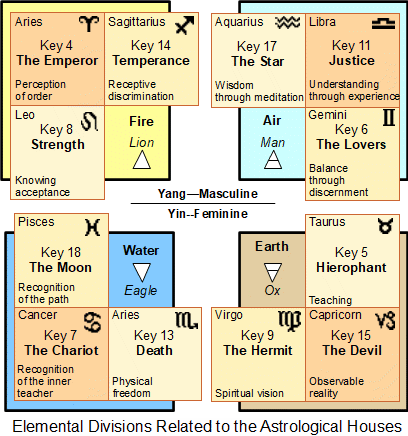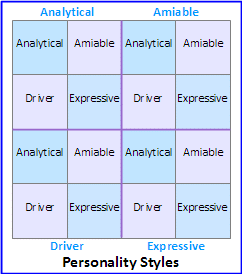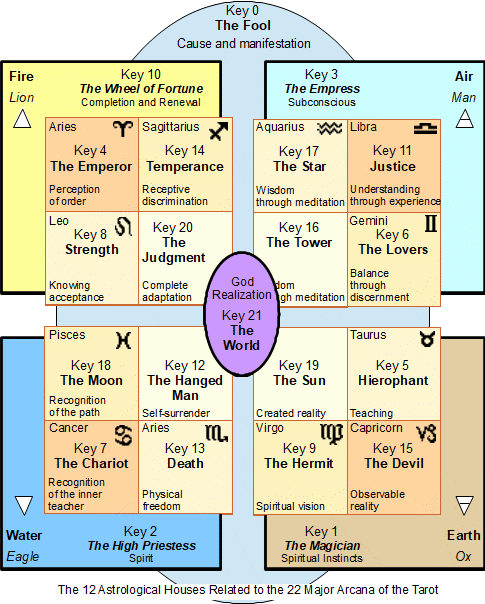Tom Butler
December 2010
 This essay was written as a talk at a Spiritualist church. My intention was to show that people differ by personality which they bring with them at birth, and which influences how they learn. This is a “technical metaphysical” view which may not be easily understood with one reading. Multiple reading, a lot of contemplation and questions in the Idea Exchange will help you see that, by your approach to learning, you decide what you learn. (Some of my terminology has changed since 2010)
This essay was written as a talk at a Spiritualist church. My intention was to show that people differ by personality which they bring with them at birth, and which influences how they learn. This is a “technical metaphysical” view which may not be easily understood with one reading. Multiple reading, a lot of contemplation and questions in the Idea Exchange will help you see that, by your approach to learning, you decide what you learn. (Some of my terminology has changed since 2010)
Introduction
Aside from the influence on personality by the planets, astrology is concerned with types of personality. Ancient wisdom schools are concerned with development of human potential and the Tarot is an important book containing much of what is taught by these schools. The evolution of personality is central to this teaching. The study of personality types in modern psychology is manifest in practical applications such as sales courses. These divergent approaches to understanding personality have surprising agreement in how typical behavioral traits (temperaments) are assigned to personality types.
This article is intended to show that people are thought to have sets of personality traits that influence how they live and react to circumstances. There is thought to be an evolution in personality as a person gains understanding of the actual nature of reality. You are not being asked to believe that astrology, the Tarot or even modern styles are correct. Nor are you being asked to determine where you fit into their categories. The objective of this essay is to show that there is an evolution of personality caused by increasing understanding of reality—what some people refer to as gaining spiritual maturity.
The most important lesson here is usually not illustrated in these systems. There is a fifth category illustrated by Key 21 of the Major Arcana of the Tarot (Figure 3). As we gain in understanding, we learn to seek a middle path by balancing emotions, desires and actions with influences of the environment. It can be said that the wise person will dwell in the middle, while easily assuming other personality types as circumstances required to maintain balance.
Personality Traits in Astrology
Astrology is based on the assumption that changing positions of heavenly bodies have changing effects on us. It is also based on close observation of human personalities. Landis Knight Green illustrates this in her book, The Astrologer’s Manual.2 In her book, she included mention of Carl G. Jung’s interpretation of personality types for the Cardinal, Fixed, and Mutable relationship which are generally used when a person is discussing the elemental qualities of the signs. Those qualities are Fire, Water, Air, and Earth.
Figure 1 illustrates this relationship. In that figure, the four Cardinal signs are situated in the figure so that the Yang or masculine signs (extroverted) are on the top and so that the Yin or feminine signs (introverted) are at the bottom. Also, the purest form of Yang (extroverted) and Yin (introverted) are at the left and the complements at the right. Complements are those signs which are not considered pure Yang or Yin. According to Jung, the Air signs, which are Yang, are also introverted or feminine to some degree. Likewise, he considers the Earth signs as Yin, but with some extroverted or masculine qualities. By contemplating the relationships illustrated in the figure, you will see that the signs are displayed as the four pure traits. These traits are arranged in relationship to one another as they relate to the individual’s personal inclination to place attention on the Self or on the created reality. Each Cardinal sign is related to the adjacent Cardinal sign by a melding of traits as indicated by the other signs in the figure.

Figure 1
With the personality types attributed to them by Carl Jung.
(Some wording and relationships amongst the signs have been changed
to illustrate the personality traits without regard to traditional astrological relationships.)
Modern View of Personality Trait
While astrology is an ancient science, personality treats remain an important study in modern times. The following personality divisions are typical of modern systems of classification3:
The four primary personality types in the “Styles” system
Analytical
An Analytical is a person who generally hides personal feelings to the point of seeming to be aloof and unemotional. This type avoids emotional involvement until thoroughly exploring the many ramifications of such a relationship. Not expecting a mate to have considered all of the facts, an Analytical will always try to control a relationship. The Analytical insists on having and examining all of the related information on a subject before making a decision and is very meticulous in living and work habits so as to maintain a controlled environment. Generally speaking, this individual prefers to interact with the environment through tabulated facts rather than by interacting with it directly. Because of this, an Analytical will generally resort to tried and proven methods rather than risk the unknown by following a new path.
Driver
The Driver is accustomed to taking charge of situations to get things done. The take charge attitude does not necessarily inspire others to follow and so the Driver is frequently a loner. From the perspective of the other three styles, the Driver is a risk taker and does not hesitate to exert available authority over others to get the job done. This trait may be the result of the ability to intuitively see the whole picture at a glance rather than depending on properly tabulated data. Such ability puts the Driver in the situation of waiting for others to arrive at the correct conclusion as he or she understands it to be. An apparent certainty that others will never arrive at the correct conclusion in time is probably what leads the Driver into a no-nonsense, take-charge behavior.
Amiable
The Amiable is the person you would like to have as a neighbor or in-law. This is a person who can find happiness in simple day-to-day activities as long as they are socially oriented. Amiables are people first and business last type of people. Facts and figures are not interesting to them and getting things done is only important if people are dependent on it. This person operates from a strongly sensory perspective of reality that includes a clear understanding (or at least the potential for understanding) of the relationship between oneself and the environment.
Expressive
The Expressive is a natural leader able to mix objectives with concern for others. Like the Amiable, the Expressive puts people’s interests before processes. Also, like the Driver, he is able to recognize a goal and how to get there. The Expressive is capable of leading the charge down the wrong path but generally balances this with his people skills such as building teams with balancing skills.
In this modern system, each trait is also blended with adjacent traits in recognition that most people have a primary personality trait blended with a tendency toward one or more of the other traits. The lesson for sales people is to tailor a sales presentation to fit the needs and interests indicated by the customer’s personality. As an example, if the customer is the type of person that is always in a hurry, the salesperson would do best to skip the small talk.
Figure 2 illustrates the relationship between the primary personality attributes described above and the twelve astrological signs. Notice in the figure that the four major categories are related, not only to the adjacent traits, but to the traits that are diagonal to them in the figure.

Figure 2

Figure 3
The twelve astrological signs related to the twenty-two Major Arcana of the Tarot.
Personality Traits in the Ancient Wisdom Schools
In Figure 3, the Major Arcana of the Tarot4 are included in a diagram to complete the melding of the four Cardinal traits. Note the large oval which is labeled Key 0, The Fool. The Fool is symbolic of primal Spirit or unformed Spirit from Infinite Intelligence from which Self is created. Think of Key 0 as the Self before it has taken a body for the first incarnation (in this or other venues for learning). The small oval at the center of the diagram is labeled Key 21, The World, and is symbolic of the Self having achieved God-Realization (great spiritual maturity). This is the stage in Self’s development at which the person is ready to evolve to a realm of reality which is energetically more in agreement with Infinite Intelligence. Between Key 0 and Key 21 are Keys representing the various stages of spiritual maturity and their associated lessons. There is a direct correlation between the twelve signs in astrology and the Major Arcana of the Tarot, which are placed in the squares assigned to them.
There is also a relationship between the four primary personality types and the four elements. In general:
The Fire elemental and its associated Keys are mostly oriented toward considerations of raw matter and formation. They are concerned with new beginnings and dawning recognition that there are rules of order with which Self is to create. This involves a process of repeated incarnation into venues of learning until sufficient spiritual maturity has been gained by Self to permit the individual to recognize the nature of reality beyond the obvious or the popular wisdom.
The Water elemental embodies Self-Realization and recognition of the path with the help of the spiritual hierarchy. Here, the individual discovers that the power the environment has to influence his or her experience is only the power which it has been given by the individual. By accepting that there is a reality beyond what is seen, and by deliberately seeking to understand the nature of reality, the individual finally begins to move on to venues of learning which are more in agreement with Infinite Intelligence. (In the ancient wisdom schools, this is often phrased as “step away from the cycle of incarnations”; however, the concept of reincarnation intended here is very different from what is intended by modern vernacular.)
Air is the elemental that best describes the individual during spiritual growth. The wisdom and insights gained during meditation and contemplation moves the seeker further on the path toward self-mastery.
The Earth elemental include the group of Keys that best describe Self as the spiritual master. The seeker has arrived near the end of the path in this local venue for learning (many different venues of which the physical is just one) and begins to respond to the inner urging to teach others. Here, the seeker is represented as one who sees reality as it really is and understands his or her relationship to it. This leads to God-Realization as indicated by the inner oval – Key 21
Summary
It is important to understand that this essay should not be understood to say that astrology or ancient wisdoms are right as systems of belief. No such statement can be made without explanation which is beyond the scope of this essay. You are being asked to focus on the idea that we humans tend to have behavior patterns or personality traits that have an influence on how we live our lives. These traits are learned and are often unconsciously acted on in our daily affairs. In fact, they are very much a product of our worldview. While some of the schools of thought teach that there is an evolution in personality, the evidence better supports the idea that we assume a dominant personality type in a venue for learning as a way to facilitate a particular learning experience. As such, a very spiritually mature person might be a very uptight person if being so might enable an important lesson.
The important lesson here is that we should seek a balance in which our behavior is not determined by habit or even instinct. At the same time, it is important to be able to assume a behavior that is appropriate to the circumstance and then easily return to balance as the need passes. Without being a spiritual master, one can only speculate on how such attainment might appear. It is clear, however, that the path to spiritual maturity includes the challenge of knowing who we are and why that is.
References
-
Tom Butler, Handbook of Metaphysics, 1994, Christopher Publishing House, Hanover, MA, ISBN: 0-8158-0485-7
-
Landis Knight Green. The Astrologer’s Manual, Modern Insights Into An Ancient Art. CRCS Publications. 1988. Sebastopol. ISBN-13: 978-0916360429.
- Myers, Steve. “Myers Briggs Personality Types.” Team Technology. co.uk/tt/t-articl/mb-simpl.htm.
-
Tarot: Builders of the Adytum, 5101 North Figueroa Street, Los Angeles CA 90042, (213) 255-7141, bota.org
![]()
